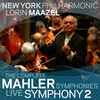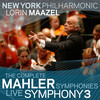Maazel, Mahler, and the New York Philharmonic
To celebrate the seven-year tenure of Lorin Maazel as Music Director of the New York Philharmonic (2002–09), the Philharmonic is releasing a set of digital recordings, The Complete Mahler Symphonies, Live – of which the first two installments are now available (Symphony No.8 will be released on August 25). Recorded between 2003 and 2009, the set underscores the special connection between the Philharmonic and the music of Gustav Mahler (1860–1911), who himself was its music director from 1909-1911. Classical Archives is pleased to present this monumental musical offering in a uniquely rich context, combining play buttons for the symphonies, along with the comprehensive liner notes from the Philharmonic's annotator, James M. Keller.
View The Complete Mahler Symphonies, Live Part 2. (Symphonies 6-10) 
 Loading, please wait...
Loading, please wait...Mahler: Symphony No. 1
- 1.Langsam. Schleppend
- 2.Kräftig bewegt, doch nicht zu schnell
- 3.Feierlich und gemessen, ohne zu schleppen
- 4.Stürmisch bewegt
Recorded live: September 22-27, 2005, Avery Fisher Hall, NY
Liner Notes
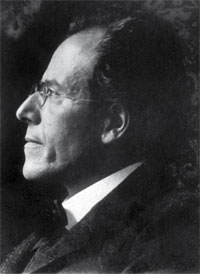
Gustav Mahler was a famous conductor by the time he embarked on the composition of his First Symphony, having quickly worked his way up through a succession of top artistic posts with musical organizations in Ljubljana, Olomuoc, Kassel, Prague, Leipzig, and Budapest.
He arrived in the last of these cities in October 1888, assuming the directorship of the prestigious Royal Hungarian Opera, and it was there that he unveiled his Symphony No.1 in late 1889. That premiere came on the heels of personal tragedies that had marred the preceding months: the death of Mahler's father in February and of both his younger sister, Leopoldine, and his mother in the autumn. This left the composer with the stress of serving as head of his remaining family while balancing the musical and substantial political challenges of his professional life. One wishes that the unveiling of his symphony could have come as a triumphant exclamation point at the end of such a difficult phase. Unfortunately, the premiere was far from successful, and the politics of Budapest continued to wear Mahler down until he finally submitted his resignation (in March 1891) and moved to Hamburg.
He would later say that the disastrous reception of his First Symphony prevented his being accepted as a composer for the rest of his career – probably an overstatement, but containing a grain of truth nonetheless. "My friends bashfully avoided me afterward," Mahler told his confidante Natalie Bauer-Lechner. "Nobody dared talk to me about the performance and my work, and I went around like a sick person or an outcast."
The work premiered in 1889 was rather different from the Symphony No. 1 as it is normally heard today. It was not even presented as a symphony; instead, the program identified it as a five-movement "Symphonic Poem in Two Sections," and it included, as its second section,an Andante which Mahler referred to as "Blumine" ("Bouquet of Flowers"). In a newspaper article that ran the day before the premiere Mahler laid out a descriptive program for the piece in which the five movements were said to depict spring, happy daydreams, a wedding procession, a funeral march to accompany the burial of a poet's illusions, and an advance toward spiritual victory.
Stung by the vehemence with which much of the audience rejected the work, Mahler set his score aside for more than three years. In 1893 – he had by then moved to Hamburg – he subjected the symphony to severe revisions, particularly in matters of orchestration. "On the whole," Mahler wrote to Richard Strauss in May 1894, "everything has become more slender and transparent." He knew this not just from his inner ear, but from concert-hall experience as well, since he had conducted the new "Hamburg version" on October 27, 1893, with considerably more success than Budapest had allowed. Strauss slated it for a musical festival he was programming just then, and arranged for Mahler to travel to Weimar to conduct it in June 1894. This time the reception was sharply divided. Mahler wrote to a friend, "My symphony was received with furious opposition by some and with wholehearted approval by others. The opinions clashed in an amusing way, in the streets and in the salons."
Mahler kept on revising. He attached further programmatic descriptions to the movements and then discarded them. When the piece was published, in 1898, the composer left only the words "Like the Sound of Nature" at the head of the score. He also eliminated the "Blumine" movement – so effectively that it remained unpublished for seven decades.
In the end, all of Mahler's travail concerning the symphony's program can be read as a reflection of the aesthetic gulf that separated proponents of "program music" and "absolute music" at that time. Mahler seems to have hoped to gain the sympathies of the "program" faction while in his heart he was himself an "absolutist." Try though he might to "justify" his music by attaching extra-musical descriptions to it, Mahler fails to convince us that his symphony's content is really motivated by anything other than the music itself.
Mahler: Symphony No. 2
- 1.Allegro maestoso. Mit durchaus ernstem und feierlichem Ausdruck
- 2.Andante moderato. Sehr gemächlich. Nie Eilen
- 3.Scherzo. In ruhig fliessender Bewegung
- 4.'Urlicht': Sehr feierlich, aber schlicht
- 5.Im Tempo des Scherzos. Wild herausfahrend
Recorded live: June 19-21, 2003, Avery Fisher Hall, NY
Liner Notes
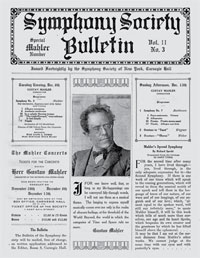
Gustav Mahler was already a famous conductor when he embarked on his Second Symphony. Following formal training in Vienna, he obtained his first professional appointment in 1880 as conductor of a summer opera theater in the Upper Austrian town of Bad Hall.
From that modest beginning he built a steadily growing reputation thanks to a quick succession of directorships with musical organizations in Ljubljana, Olomouc, Kassel, Prague, Leipzig, and Budapest, where he unveiled his First Symphony – disastrously – in late 1889.
By that time Mahler had already begun to create what would become his Second Symphony. In January 1888 he composed the first movement, which he later named Todtenfeier (Funeral Rites) and cast (and even performed) as a stand-alone tone poem. That same year Mahler had also drawn up sketches of the symphony second movement.
On July 8, 1893, Mahler completed the voice-and-piano version of the song "Des Antonius von Padua Fischpredigt" ("St. Anthony of Padua's Sermon to the Fishes"), which he would immediately transform into strictly instrumental format as the symphony's third-movement scherzo. By the end of June he also completed the second movement and the fourth movement ("Urlicht," or "Primal Light," also an orchestrated version of a song). At that point Mahler was still perplexed about the order in which the movements would fall, and he had not figured out how to end the piece – the overall structure of the Second Symphony continued to elude him.
Mahler usually reserved his summers for composing and gave over the concert seasons themselves to his conducting duties. Such was the case here, and he put aside further work on his Second until April 1894. By then, specific impetus toward the "solution" of his symphony had arrived on March 29, when he attended the memorial service for the great conductor and pianist Hans von Bülow.
As Mahler wrote three years later to the critic Arthur Seidl (not to be confused with Anton Seidl, the New York Philharmonic's music director at that time):
I had long contemplated bringing in the choir in the last movement, and only the fear that it would be taken as a formal imitation of Beethoven made me hesitate again and again. Then Bülow died, and I went to the memorial service. – The mood in which I sat and pondered on the departed was utterly in the spirit of what I was working on at the time. – Then the choir, up in the organ loft, intoned Klopstock's Resurrection chorale. – It flashed on me like lightning, and every- thing became plain and clear in my mind! It was the flash that all creative artists wait for – "conceiving by the Holy Ghost"! What I then experienced had now to be expressed in sound. And yet – if I had not already borne the work within me – how could I have had that experience?
Mahler signed off on the complete "fair copy" in Hamburg on December 18, 1894. The first three movements were played the following March and the entire symphony in December (in both cases in Berlin). Critical reception was nightmarish on both occasions, and, despite a more interested reaction from many in the audience, the work did not begin making much impact in the concert world until decades later. It was, however, the first Mahler symphony to appear on recordings, thanks to Deutsche Grammophon's release, circa 1923, of Oskar Fried and the Berlin Staatsoper Orchestra valiantly struggling to fit its immense demands into the confines of a period recording studio.
Mahler: Symphony No. 3
- 1.Kraftig Entschieden
- 2.Tempo di Menuetto. Sehr mässig
- 3.Comodo. Scherzando. Ohne Hast
- 4.Sehr langsam. Misterioso. Durchaus ppp
- 5.Lustig im Tempo und keck im Ausdruck
- 6.Langsam. Ruhevoll. Empfunden
Recorded live: June 16-19, 2004, Avery Fisher Hall, NY
Liner Notes

"I find it quite strange that people talking about nature only make mention of flowers, birds, and fresh air. But nobody seems to know Pan, the god Dionysos. Nature is able to show all those phenomena, both pleasant and horrible, and I wanted to put these things in a kind of evolutionary development in my work."
So wrote Gustav Mahler to a music critic who was trying to understand his Third Symphony, a towering monument to nature, but not so entirely reassuring a work as its subject might lead one to expect. onetheless, this longest of Mahler's symphonies is one of his most approachable, most relaxed, and least haunted by nightmares and apocalyptic visions.
Because responsibilities on the podium completely occupied him during concert seasons, Mahler largely relegated his composing to the summer months, which he invariably spent as a near hermit at one bucolic site or another in the Austrian countryside. When he came to write his Third Symphony, during the summers of 1895 and 1896, he was escaping the concert- season rigors connected to his directorship of the orchestra and opera in Hamburg.
He had assumed that post in 1891, following a peripatetic career that had already led him through increasingly prestigious music directorships at Bad Hall (his first professional appointment, which he obtained in 1880), Ljubljana, Olomouc, Kassel, Prague, Leipzig, and Budapest.
Mahler's preferred summer retreat, for the moment, was the village of Steinbach on the Attersee, in the breathtakingly beautiful Salzkammergut of Upper Austria, some 40 miles southwest of Linz. Initially this symphony was to be called The Happy Life, a Summer Night's Dream (not after Shakespeare… reviewer's notes), and each of its six movements was to carry an individual title: "What the Forest Tells Me," "What the Twilight Tells Me," "What Love Tells Me," "What the Flowers of the Meadow Tell Me," "What the Cuckoo Tells Me," and "What the Child Tells Me."
As Mahler worked on the symphony he revised his program and titles considerably. Just after completing the work Mahler enumerated the movements' revised titles in a letter to Max Marschalk on August 6, 1896:
-
Part One:
- "Pan Awakes. Summer Marches In. (Pan's Procession)"
-
Part Two:
- "What the Flowers of the Meadow Tell Me"
- "What the Animals of the Forest Tell Me"
- "What Man Tells Me"
- "What the Angels Tell Me"
- "What Love Tells Me"
The movements were separated into two uneven parts: the first movement (itself lasting just over a half hour, which is to say, a third of the symphony's total running time) alone comprising the first part, the remaining five movements the second.
That's how things stood until the piece was finally premiered in 1902, when suddenly Mahler decided to dispense with the programmatic titles along with most of the rather detailed programmatic markings he had previously placed within the course of the movements. How to explain all this shilly-shallying? Mahler tried to, in a letter to the conductor Josef Krug-Waldsee: Those titles were an attempt on my part to provide non-musicians with something to hold onto and with signposts for the intellectual, or better, the expressive content of the various movements and for their relationship to each other and to the whole. That it didn't work (as, in fact, it never could work) and that it led only to misinterpretations of the most horrendous sort became painfully clear all too quickly.
Those titles ... will surely say something to you after you know the score. You will draw intimations from them about how I imagined the steady intensification of feeling, from the indistinct, unyielding, elemental existences (of the forces of nature) to the tender formation of the human heart, which in turn points toward and reaches a region beyond itself (God).
This last comment goes to the heart of the Third Symphony perhaps more than any other, but one has trouble overcoming the lingering suspicion that the earlier titles in fact have a great deal to do with what this piece is about.
Mahler: Symphony No.4
- 1.Bedächtig. Nicht eilen
- 2.In gemächlicher Bewegung. Ohne Hast
- 3.Ruhevoll
- 4.Sehr behaglich. 'Wir genießen die himmlischen Freuden'
Recorded live: September 20-26, 2006, Avery Fisher Hall, NY
Liner Notes
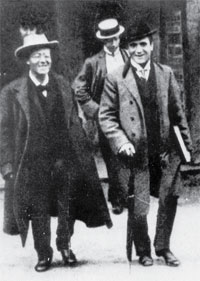
Throughout his career Gustav Mahler balanced the competing demands of his dual vocation as a composer and conductor. Responsibilities on the podium and in the administrative office completely occupied him during concert season, forcing him to relegate his composing to the summer months, which he would spend as a near hermit in the Austrian countryside. When Mahler came to write his Fourth Symphony, principally during the summers of 1899 and 1900, he was escaping a Vienna that was becoming a source of inordinate stress. On April 1, 1901, he would be ousted from his position as Director of the Vienna Philharmonic following a three-year tenure in which the normal roller coaster of Viennese musical politics was rendered more intense by the anti-Semitic sentiments that often dogged him. He was hanging on to his other principal position, as Director of the Vienna Court Opera; however, that job was stressful, too, and Mahler's anxiety at work led to frequent medical problems.
He spent the summer of 1899 at Bad Aussee in the Salzkammergut, and during his last ten days there he began to map out his Fourth Symphony. In August he filed his sketches away and did not return to them until the following summer, this time at a new location. His getaway was now the villa he was building at Maiernigg, a bump on the map on the south shore of the Wörthersee (known sometimes as Lake Worth to English speakers, to the extent that English speakers know it at all), a bucolic spot in the region of Carinthia in southern Austria.
At Maiernigg Mahler had constructed a tiny, sparsely furnished composing cottage on the hill behind his villa; every morning he would meander up along a forest path to work there in splendid seclusion. When he returned to his composing that summer he discovered, as he reported to his amanuensis, Natalie Bauer-Lechner, that his work had progressed to:
a much more advanced stage than it had reached in Aussee without my having given it a moment's real attention in the meantime. That my second self should have worked on the symphony throughout the ten months of winter sleep (with all the frightful nightmares of the theater business) is unbelievable!
By August 5 the Fourth Symphony was effectively completed, although Mahler continued to revise it through the following April – and, indeed, to tweak it further following performances that he conducted, through to his last one, with this New York Philharmonic, four months before he died.
Mahler had a head start with this symphony. In 1892 he had written a song – first to a piano accompaniment, a few weeks later in an orchestral version – titled "Das himmlische Leben" ("The Heavenly Life") on a text drawn from the purported folk anthology Des Knaben Wunderhorn. That collection furnished texts for quite a few of his independent songs as well as for movements of his Second and Third Symphonies. Mahler contemplated using his setting of "Das himmlische Leben" to conclude his Third Symphony but he discarded the idea – a wise choice since that work was already quite long and probably too massive for such a pared-down ending. Instead, the song became the point of departure for his new symphony. In his Fourth Symphony, Mahler worked backwards to some degree; knowing how it would conclude, he crafted the first three movements to prepare for that song-finale, which he once referred to as "the top of the Symphony's pyramidal structure."
Surely this ending succeeds far better here than it would have in the Third Symphony, capping as it does an extensive, incident-laden first movement, a wry scherzo (Mahler indicated that he intended it as a sort of danse macabre), and a supernal Adagio (which Mahler ranked as his finest slow movement, although his oeuvre offers several worthy competitors). Everything reaches its destination in one of Mahler's simplest songs. Moreover, that song is intoned by a soprano who, Mahler insisted (in a note he inserted in the first edition of the score), should render her four verses "with childlike, cheerful expression; entirely without parody!"
Mahler: Symphony No. 5
- 1.Trauermarsch. In gemessenem Schritt. Streng. Wie ein Kondukt
- 2.Stürmisch bewegt. Mit größter Vehemenz
- 3.Scherzo. Kräftig, nicht zu schnell
- 4.Adagietto. Sehr langsam
- 5.Rondo-Finale: Allegro
Recorded live: September 18-23, 2003, Avery Fisher Hall, NY
Liner Notes

Throughout his career Gustav Mahler balanced the competing demands of his dual vocation as a composer and conductor. Responsibilities on the podium and in the administrative office completely occupied him during concert seasons, forcing him to relegate his composing to the summer months, which he would spend as a near-hermit in the Austrian countryside. When he came to write his Fifth Symphony, during the summers of 1901 and 1902, he was escaping a Vienna that had become a source of inordinate stress. On April 1, 1901, he was ousted from his position as Director of the Vienna Philharmonic following a three-year tenure in which the normal roller coaster of Viennese musical politics was rendered even more intense by the anti-Semitic sentiments that often dogged Mahler. He was hanging on to his other principal position, as Director of the Vienna Court Opera, but that job was stressful, too, and Mahler's anxiety at work led to frequent medical problems.
Fortunately he had his composing to look forward to. His summer getaway was now at Maiernigg, a bump on the map on the south shore of the Wörthersee (known sometimes as Lake Worth to English speakers, to the extent that English speakers know it at all), a bucolic spot in the region of Carinthia in southern Austria. Mahler was in the process of building a villa on the lake, and the construction would be completed while this symphony was in progress. Another important event occurred while he was working on this symphony: in November 1901, at a dinner party, he met Alma Schindler, who was just then ending her liaison with her composition teacher, Alexander von Zemlinsky. Gustav and Alma were smitten with one another and they married a few months later, on March 9, 1902, having already set about making their first child, Maria, who arrived on November 2. It would be a complicated and often unhappy marriage, although they stayed together until Mahler's death in 1911. After that Alma would marry and divorce the architect Walter Gropius, marry and survive the novelist Franz Werfel, and enjoy romantic adventures with several other overachievers in the arts. Back in 1902, when the Fifth Symphony was being completed, the Mahlers were newlyweds and already there were problems, not least of which, so far as Alma was concerned, were the frequent visits paid by one of their neighbors, a Wagnerian soprano with whom Gustav had had an affair years earlier.
At Maiernigg Mahler had constructed a tiny, sparsely furnished composing hut on the hill behind his villa, and every morning he would meander up along a forest path to work in splendid seclusion. The seclusion was mandated: a servant-girl, for example, would leave the villa moments after him on a more direct trail so she could deposit his breakfast at the hut and make her getaway before he arrived.
What Mahler achieved during those two summers marked his return to the purely instrumental symphony. His First Symphony had been strictly orchestral, but the three that followed it all expanded the forces by using singers, whether as soloists or in chorus or both. But if Mahler's Fifth Symphony is not unusually radical in the forces it requires (extensive though they be), his use of those forces is profoundly imaginative. On top of that, its structure is curious indeed. The piece unrolls over five movements (rather than the classic four of most symphonies), and those movements are grouped into three overriding sections: the first and third sections both comprise two movements, while the Scherzo stands in the middle as a section unto itself. From its opening, ominous trumpet fanfare through to its majestic conclusion an hour and a quarter later (and a semitone higher), the Fifth Symphony traces a panorama of human emotions. In 1911 Mahler remarked that his Fifth Symphony had come to represent "the sum of all the suffering I have been compelled to endure at the hands of life." For us, too, it may convey suffering, but also joy, hope, and 100 other signs of the human condition.












